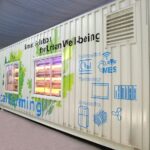ASIA ELECTRONICS INDUSTRYYOUR WINDOW TO SMART MANUFACTURING
Green Factories Propel US$620B Smart Manufacturing Market by 2026
According to TrendForce research, companies are moving actively on energy conservation and carbon reduction. In the short term, the introduction of automation as an intelligent foundation will attract increasing attention from the industry and emerging market demands, such as remote operations, virtual reality, and simulation operations will become more practical in the medium term. This stage of development is expected to solve the dilemma posed by the slow progress of Industry 4.0, accelerate the development of related technologies, and drive the global smart manufacturing market to reach US$620 billion by 2026.

Special Focus on Energy Conservation
Based on the study, there are quite a variety of ways for the manufacturing industry to move towards sustainable operation. Looking at the common man-machine-material law in factory management, design of low-carbon machinery and equipment, selection of packaging materials, circular economy business model, use of renewable energy, and even the use of green construction facilities are all tools and means. Considering cost and benefit, production process improvement and overall environmental monitoring are key areas of current Industry 4.0 greening technology.
Take the Sustainability Lighthouses selected by the World Economic Forum as an example, these smart factories utilize a plethora of Industry 4.0 technologies and focus on energy conservation and carbon reduction. Compared with manufacturers focusing on energy optimization in 2021, the 2022 selection is more comprehensive with Western Digital, Schneider Electric, and Johnson & Johnson Janssen improving overall efficiency and migrating to green factories through technical tools such as digital twin unmanned factories, IIoT real-time energy management and control systems, and AI process management.
Looking further at overseas business opportunities for Taiwanese green factories, manufacturers with an existing overseas foundation will hold a relatively potential advantage. Also, they will be pressed to move their products and services closer in line with energy conservation and carbon reduction, such as Tongtai Machine & Tool forging green machine tools to maintain overseas competitiveness through strategies such as visual monitoring, digital twinning, and carbon inventory to reduce its carbon footprint, and using lightweight, innovative materials and power-saving motors in its designs.
Meanwhile, TECO developed equipment systems that can reduce material loss and convert waste heat into green electricity. HIWIN‘s intelligent ballscrew can identify the best lubrication timing to reduce lubricant use/waste and carbon emissions. Delta Electronics uses low-carbon industrial automation as an entry point to focus on renewable energy power generation and energy storage systems, motor inverters, and others.
More Companies Will Join Bandwagon
Since carbon neutrality cannot be achieved overnight, even if the use of intuitive green products and services or renewable energy are adopted, related supporting measures are still required to maximize benefits. Therefore, more manufacturers are expected to accelerate their digital transformation and introduce industrial automation to lay green foundations in 2023, which will also become the main driving force for annual growth in the market. In the medium and long term, companies can obtain data through automation to improve quality and then reduce waste and connect entire plants through digital virtualization.
Finally, companies can use the least resource intensive, environmentally friendly production process with integrated energy management, while maintaining market competitiveness and building a decarbonized business model for a circular economy. Under the interlinked and multi-linear automatic, virtual, and low-carbon development framework, the critical core of a glorious decade for the smart manufacturing industry will be built with green manufacturing as a goal.




